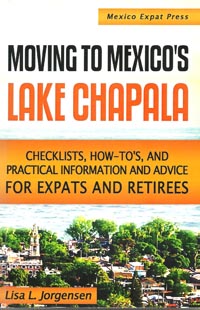Good Reading
 Moving to Mexico’s Lake Chapala: Checklists, How-To’s, and Practical Information and Advice for Expats and Retirees
Moving to Mexico’s Lake Chapala: Checklists, How-To’s, and Practical Information and Advice for Expats and Retirees
By Lisa L. Jorgensen
Mexico Expat Press, 2012
Available from Amazon Books: Paperback
This book really does tell you about everything you need to know if you are planning to move to Lake Chapala, one of the most popular retirement sites in the world for North Americans. Alejandro Grattan-Dominguez, Editor-in-Chief of El Ojo del Lago, has this to say: “I found it highly readable, most comprehensive, and flawlessly organized. I think it’s the best book of its kind that I have read, and I have been down here for 25 years.”
Jorgensen sensibly organizes the book into five parts, followed by a useful appendix.
Part I: Your Exploratory Trip includes a chapter “Planning Your Trip” and a chapter “During Your Trip.” There we discover that “A minimum of $1,200 per month for a single or $1,600 for a couple is enough for a decent living in this area.” Once in Ajijic, which she recommends for your exploratory trip since it is the center of activity for expatriates, she suggests that you have “two base camps: the B & B where you’re staying, and the (non-profit) Lake Chapala Society, which will most likely become like a second home….” Aside from being a “whole world of information, activities, classes, community postings, health screenings, volunteer and charity opportunities,” it also has the “largest Mexican library of books in English.”
Part II: Before Your Move makes simple everything you need to do, including matters of finance, your moving date (“a firm move date will focus your mind”), what to say to family and friends you will leave behind, how to bring your beloved pets across the border, what to do regarding your car and belongings, what you should bring, what you should leave behind. Jorgensen managed to reduce her possessions to what she could fit into her jeep, and those included “two cats, a cat carrier, two medium dogs, two dog beds, and three 12-packs of Diet Dr. Pepper — all without a rooftop carrier. In the final four chapters of this section she methodically and in high detail tells what to do “Four Weeks Before Moving,” “Three Weeks Before Moving,” “Two Weeks Before Moving,” and “One Week Before Moving,” which includes “Print out a copy of the Jalisco and federal driving laws located in the Appendix.”
Part III: Your Move finds us actually on the road and headed to the border. While still in the US, Jorgensen offers tips like “If you’ve brought pets, it’s good to know that all US Motel 6 motels always take them, because you’ll find them everywhere.” Once at the border, you’ll need an FMM tourist card, vehicle permit, and you’ll have to pass through customs. These matters are explained in detail, along with Mexican car insurance.
Part IV: Your First Month at Lake Chapala is conveniently organized into four chapters telling what you need to do each of your first four weeks. The first week, for example, you should get local maps at the real estate offices, you should write out a list of emergency numbers, you should change the locks on your doors, you will want to explore options for phone, television, find names of good handymen, sign up for membership at The Lake Chapala Society, and so on.
Part V: Living at Lake Chapala is not like living north of the border. “Life north of the border is more predictable, more regulated, more automated, more expensive, and more bland.” This is in high contrast to colorful Mexico where “life… is a continuous adventure.” In this section you learn about the legal basics, about the towns at Lake Chapala — all with cobblestone streets-with names like Ajijic (pronounced ah-hee-HEEK), San Antonio Tlayacapan, Chapala, San Juan Cosalá, and Jocotepec. You will also learn about language classes, social customs, banking, shopping and negotiating prices, and about how to get around. You will learn about local health care, the Mexican national health insurance — IMSS — which gives full health coverage and costs around $270 USD per year.
The Appendix gives you in simple format checklists for your exploratory trip, which include Four Weeks Before Moving, Three Weeks…, Two Weeks, etc., as well as a Border Checklist, a Moving In Checklist, Emergency Numbers (and common emergency words in Spanish), Telephone Dialing, Web Boards, Recommended Reading (eg., the local magazines in English, El Ojo del Lago and the Lake Chapala Review), Jalisco Driving Laws and Fines, conversions (temperature, weight, etc.) and so on. The Appendix alone is worth the price of the book.
Is the information current? You bet! Why? Because Lisa Jorgensen only moved here this past spring.
In the Lake Chapala area, Moving to Mexico’s Lake Chapala is available at Diane Pearl’s Colecciones and The Lake Chapala Society among others. You also may want to check out www.movingtomexicoslakechapala.com.

